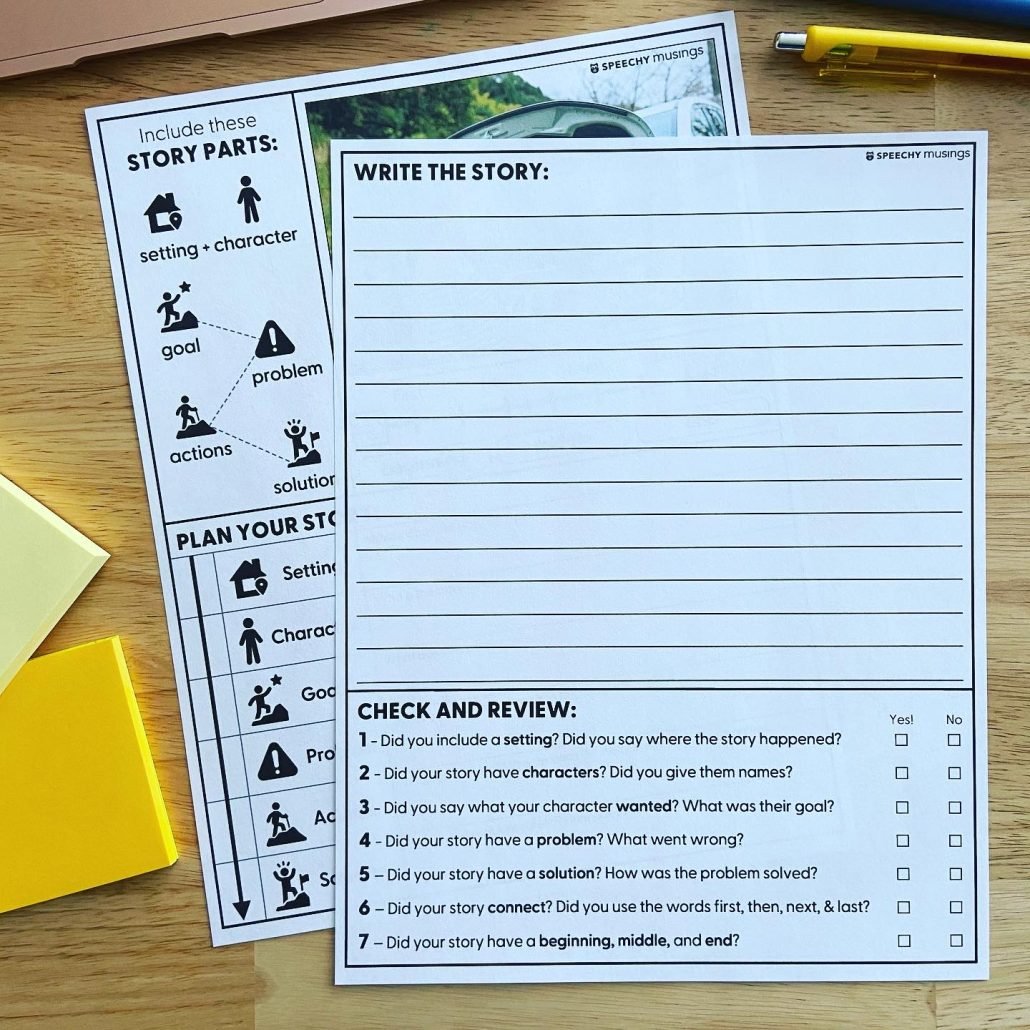Story Generation Goal Ideas
- Given a picture or a series of pictures, NAME will formulate 4 or more grammatically correct sentences to tell a short narrative based on the picture(s) in 70% of opportunities.
- NAME will tell a personal story including a clear beginning, middle, and end in 3 out of 5 opportunities given moderate verbal cues and a familiar visual.
- NAME will verbally tell a narrative using 3 or more story grammar parts (e.g., character, setting, problem, feeling, solution) in 2 out of 3 opportunities across 3 sessions.
- Given a familiar graphic organizer and minimal support, NAME will analyze their writing sample in order to confirm that it contains at least 5 narrative elements (e.g., character, setting, problem, feelings, solution ) in 4 out of 5 opportunities.
Read more about my goals here.
Story Generation Resources
Here are my favorite resources that target storytelling skills for speech therapy:
Teaching Story Generation Skills
Story generation can be more engaging and preferred for children compared to Story Retell, but it is also a more difficult skill overall. Reasons why many students prefer it is that they enjoy talking about their experiences and interests and that its often perceived as less intimidating because they aren’t expected to replicate a specific story (Swason et al, 2005).
Story generation, or creating and telling stories, requires a lot of other foundational language knowledge and skills. For example, you must have general knowledge about the situation/event, understand verb tense, be familiar with story structure and organization, use temporal concepts (first, next, last), and understand the perspective of the listener.
One important thing to note is that the way you elicit a story will effect the type of story your learner tells.
Some scenarios elicit problem/solution stories (tell about a time you got jealous!) and others elicit sequential stories (tell a story about going to the library).
To introduce this skill of story generation, I love using real pictures and lots and lots of visuals.
We pull from our knowledge of Story Elements but this time, our focus is on having each student tell their own version of a story.
Providing increased structure, like in this photo, helps my students expand their stories instead of providing a very short, simple story.
The supports you give your students could be adapted to make stories longer or shorter depending on each student’s language level.
Once my students are demonstrating success with more structured story generation tasks like the ones shown above, I move onto story generation using more complex stories and visuals.
The understanding of story structure is key here.
Here’s another visual that illustrates story structure that is perfect for directly teaching episode structure, story elements, and story generation skills:

Once students are familiar with the concepts above, I would recommend targeting the creation of parallel stories!
Read on for ideas on how to do this. ⬇️
Putting It Into Context
The primary way I target story generation in context is through the use of parallel stories.
Parallel stories are when you take the structure from one story and create your own story using that same structure.
For example, if you read a story about someone who was searching for their missing toy, your students could generate a parallel story about a time they searched for something they had lost.
You can also easily incorporate work on writing skills while targeting story generation and creating parallel stories.
Here’s an example of an activity that builds on the story structure taught and shown above:
Here’s the steps I follow to build from story retells to creating parallel stories (adapted from Peterson et al, 2014):
- Tell the story while directly calling attention to each story element (using visuals).
- Provide the same visuals to the student and have them retell the story with support.
- Have the student independently tell the story.
- Prompt the student to generate their own story using the same story elements and order (e.g., first introduce the character and setting, then have a lift-off event, then describe a problem, etc..).
- Sketch the story in boxes, scene by scene (the Story Squares freebie linked below works great for this!).
- Have the student retell their story using the sketches and visuals.
- Have the student independently tell their story.
- If desired, have the child tell the story again after a break (next session, after another activity, etc…) to solifiy the skill.
- Together with the student, check and review their story. Have them assess their story to make sure it was complete, in order, made sense, and all of the parts connected to one another (see the photo below as an example).

You can follow these steps to work on story generation with a variety of students, on a variety of topics, and for a variety of language levels. Just scaffold the level of verbal and visual supports you’re providing during each step!
If this was helpful, you should definitely check out my story units. Each one includes a “story path” likes the visuals shown above, that will help you improve your students’ storytelling skills!
Shop Story Units









